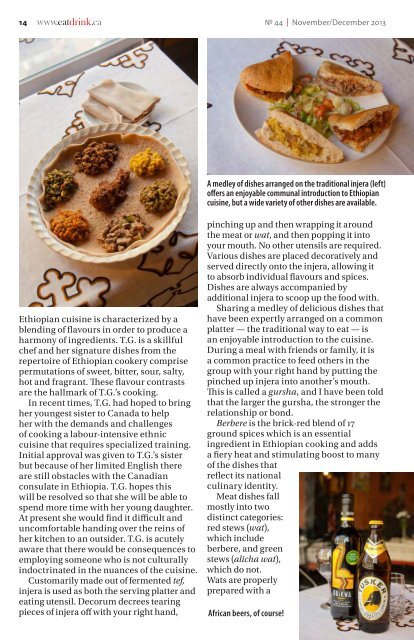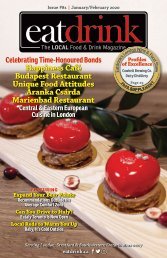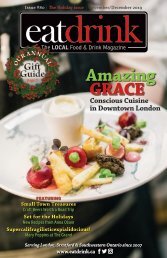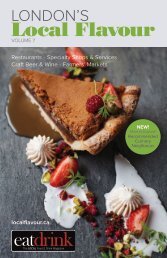Eatdrink #44 November/December 2013
The LOCAL food and drink magazine serving London, Stratford and Southwestern Ontario since 2007.
The LOCAL food and drink magazine serving London, Stratford and Southwestern Ontario since 2007.
Create successful ePaper yourself
Turn your PDF publications into a flip-book with our unique Google optimized e-Paper software.
14 www.eatdrink.ca<br />
№ 44 | <strong>November</strong>/<strong>December</strong> <strong>2013</strong><br />
A medley of dishes arranged on the traditional injera (left)<br />
offers an enjoyable communal introduction to Ethiopian<br />
cuisine, but a wide variety of other dishes are available.<br />
Ethiopian cuisine is characterized by a<br />
blending of flavours in order to produce a<br />
harmony of ingredients. T.G. is a skillful<br />
chef and her signature dishes from the<br />
repertoire of Ethiopian cookery comprise<br />
permutations of sweet, bitter, sour, salty,<br />
hot and fragrant. These flavour contrasts<br />
are the hallmark of T.G.’s cooking.<br />
In recent times, T.G. had hoped to bring<br />
her youngest sister to Canada to help<br />
her with the demands and challenges<br />
of cooking a labour-intensive ethnic<br />
cuisine that requires specialized training.<br />
Initial approval was given to T.G.’s sister<br />
but because of her limited English there<br />
are still obstacles with the Canadian<br />
consulate in Ethiopia. T.G. hopes this<br />
will be resolved so that she will be able to<br />
spend more time with her young daughter.<br />
At present she would find it difficult and<br />
uncomfortable handing over the reins of<br />
her kitchen to an outsider. T.G. is acutely<br />
aware that there would be consequences to<br />
employing someone who is not culturally<br />
indoctrinated in the nuances of the cuisine.<br />
Customarily made out of fermented tef,<br />
injera is used as both the serving platter and<br />
eating utensil. Decorum decrees tearing<br />
pieces of injera off with your right hand,<br />
pinching up and then wrapping it around<br />
the meat or wat, and then popping it into<br />
your mouth. No other utensils are required.<br />
Various dishes are placed decoratively and<br />
served directly onto the injera, allowing it<br />
to absorb individual flavours and spices.<br />
Dishes are always accompanied by<br />
additional injera to scoop up the food with.<br />
Sharing a medley of delicious dishes that<br />
have been expertly arranged on a common<br />
platter — the traditional way to eat — is<br />
an enjoyable introduction to the cuisine.<br />
During a meal with friends or family, it is<br />
a common practice to feed others in the<br />
group with your right hand by putting the<br />
pinched up injera into another’s mouth.<br />
This is called a gursha, and I have been told<br />
that the larger the gursha, the stronger the<br />
relationship or bond.<br />
Berbere is the brick-red blend of 17<br />
ground spices which is an essential<br />
ingredient in Ethiopian cooking and adds<br />
a fiery heat and stimulating boost to many<br />
of the dishes that<br />
reflect its national<br />
culinary identity.<br />
Meat dishes fall<br />
mostly into two<br />
distinct categories:<br />
red stews (wat),<br />
which include<br />
berbere, and green<br />
stews (alicha wat),<br />
which do not.<br />
Wats are properly<br />
prepared with a<br />
African beers, of course!


















